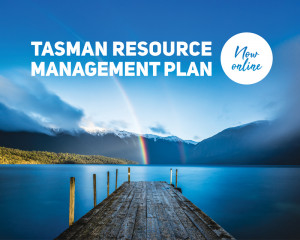Tasman District Council is a unitary authority, meaning it carries out the function of both a Regional and District Council. The Tasman Resource Management Plan (TRMP*) contains both District and Regional rules in one Plan (* the TRMP is currently under review, please check out Shape Tasman for further detail).
This guide covers the most common farming activities and indicates which ones trigger the need to apply for Resource Consent. Under the Resource Management Act 1991, you must apply for Resource Consent if you wish to do something not permitted by our regional plans.
This guide does not represent the full detail of Tasman's rules. You should also be aware of Government rules that could also apply to your activity.
Before doing any work on farm, we recommend you assess your proposed activity against these rules to make sure you comply with our permitted activity status or if you may need to apply for Resource Consent. We appreciate this is a lot of complex information. If you have any doubts about whether your proposed work will need Resource Consent or not, or have any questions, please contact our Duty Planner via NRDutyPlanner@tasman.govt.nz.

Tasman's Resource Management Plan (TRMP) Goes Digital!
After 27 years in paper form, the TRMP is now accessible online. Whether you're at home, in the office, or out in the field, you can access the plan anytime, anywhere.
Features:
Most helpful in this section is Chapter 2 which defines certain words used in the Plan. It includes everyday words that have a special application in the context of the Plan. Also included are specialist or technical words which need to be defined.
Chapters 16-18 address the general, zone, and special area rules applying to land uses and subdivisions.
This section deals with land uses in relation to stopbanks and berm lands where flood hazards may occur.
This section includes rules relating to constructing or altering bores in the District. Refer to Part 5 - Chapter 31 for rules about the taking of water from bores.
Rule 16.12 Bore Construction and Alteration
All land in the District is zoned. The zoning is shown on the Planning Maps. This chapter sets out the rules for each of the zones.
It contains land use rules for the Rural 1, 2, and 3 Zones. There are specific rules for each Rural Zone that include:
Special Area rules apply in parts of the District and relate to activities such as the destruction or removal of vegetation, soil disturbance, or earthworks. They apply in addition to the Zone rules and any relevant General rules.
All Special Area Rules can be viewed here
The most relevant rules for the Rural Sector are found here: Rule 18.5 Land Disturbance Areas
Rule 18.5.2 Land Disturbance Area 1
Rule 18.5.3 Land Disturbance Area 2 (Separation Point Granite)
Chapter 28: Rules for Activities in the Beds of Rivers and Lakes
Rule 28.1 Structures, culverts, fences, pipes and cables, bed disturbances, and plantings
Rule 28.3 Entering and passing across beds
Rule 28.4 Activities on the surface of rivers and lakes
This factsheet (pdf 2.1 MB) will assist by providing definitions, examples, and a list of factors to consider when determining what a ‘river’ is.
Chapter 31: Rules for Water Take, Diversion, Use, or Damming
Rule 31.1.2 Water Takes, Diversions, and Use
Rule 31.1.3 Diversion of Water by Structures
Rule 31.1.4 Damming of Freshwater
Rule 31.1.5 Damming and Diversion of Flood Waters
Rule 31.1.6 Diversion and Take of Water from Naturally Occurring Wetlands
Rule 31.1.7 Site-to-Site Transfer of Water Take
Chapter 36: Rules for Contaminant Discharges
Rule 36.1 Discharges to Land: Rules relating to the discharge of farm dairy and other animal effluents, fruit dump water, vegetable processing water, domestic wastewater, leachate from compost and offal pits to land.
Rule 36.2 Discharge to Freshwater or Coastal Water: Rules relating to discharges caused by land disturbance activities, works in the bed of waterways, and stock crossings.
Rule 36.3 Discharges to Air: Rules relating to discharges of contaminants to air, including outdoor burning.
Rule 36.4 Discharges or Diversion to Land or Water: This section contains rules relating to containments entrained within stormwater that is discharged to land or water.
Rule 36.5 Discharges to Land or Air: This section deals with discharges of fertilisers to land or air.
Rule 36.6 Discharges to Land, Water, or Air: This section deals with the discharge of pesticides to land, water, or the air.
Rule 36.7 Discharges to Water in Water Management Areas or Coastal Waters: This section states the requirements for any discharge of a contaminant into waters in water management areas or coastal water that are subject to a water quality classification.